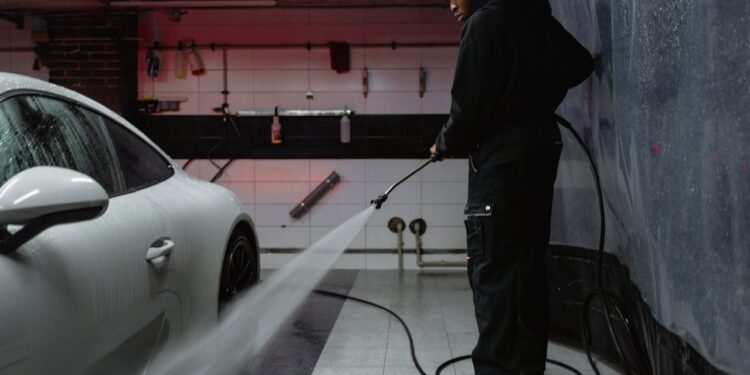Let’s be honest: there’s nothing more satisfying than seeing your car gleaming after a good wash. And with jet washers becoming a staple in Ugandan homes and garages, it’s never been easier to give your ride that “just-detailed” look. But here’s a question most drivers never think to ask—can using a jet wash actually damage parts of your car like the shock absorbers?
You’d be surprised at the answer. While pressure washers are incredibly useful, they can also be a hidden danger to your vehicle’s suspension system if not used carefully. Let’s dig into it.
Understanding Shock Absorbers
What Are Shock Absorbers?
Shock absorbers are hydraulic devices designed to control the movement of your car’s suspension. They keep your tires on the road, absorb bumps, and prevent your vehicle from bouncing uncontrollably after hitting potholes or speed bumps.
Why Are They So Important?
Without shock absorbers, your ride would feel like you’re bouncing on a trampoline. More importantly, compromised shocks reduce your ability to brake and steer safely—especially on Uganda’s unpredictable roads.
What Is a Jet Wash?
The Basics of Jet Washing
Jet washers (also called pressure washers) shoot water at high velocity using a motorized pump. They make short work of mud, dust, and grime—especially in places you can’t reach with a cloth.
Types of Pressure Washers
- Low-pressure (1,200–1,800 PSI) – Great for delicate surfaces.
- Medium-pressure (1,900–2,800 PSI) – Common for vehicle washing.
- High-pressure (3,000+ PSI) – Often overkill for cars, and risky.
How Jet Washing Can Impact Vehicle Components
While jet washers clean well, they can damage sensitive parts if used incorrectly.
Sensitive Areas at Risk
- Rubber seals
- Suspension joints
- Brake lines
- Paint and trim
- Electrical connectors
Common Causes of Damage
- Using too much pressure
- Spraying directly at joints or seals
- Washing too close to the component
Can Shock Absorbers Be Damaged by a Jet Wash?
The short answer: yes, but it’s rare—and mostly due to misuse. Shock absorbers are sealed units, but their surrounding components like bushings, mounts, and seals can suffer if blasted directly with a high-pressure stream.
Water Pressure and Seal Damage
Seals around the shock can be worn down or forced open under pressure. Once a seal is compromised, moisture can enter the unit, leading to internal rust or oil leaks—and eventually, total failure.
Dirt Forcing and Internal Contamination
Ironically, blasting mud from underneath your car can force debris into the shock mounts or joints. Over time, this can grind down moving parts and shorten the lifespan of your shocks.
Signs Your Shock Absorbers Might Be Compromised
Keep an eye out for these red flags:
- Car dips excessively when braking
- Feels unstable on rough roads
- Leaking fluid near the wheels
- Uneven tire wear
- Clunking noises
If any of these sound familiar, it’s time to have your suspension checked—especially after a heavy jet wash session.
Safe Jet Washing Tips to Protect Your Suspension
Here’s how to clean your car without wrecking your shocks:
- Keep the nozzle at least 2 feet away from suspension components
- Never spray directly at seals, bushings, or joints
- Use a fan nozzle, not a pinpoint jet
- Stick to 1,200–2,000 PSI for car washing
Recommended Pressure Settings
| Task | Recommended PSI |
|---|---|
| General car wash | 1,200 – 2,000 |
| Undercarriage cleaning | 1,500 – 2,000 |
| Heavy grime removal | Up to 2,800 (with care) |
Professional Car Wash vs DIY Jet Wash
While DIY saves money, professional car washes know how to angle the pressure correctly and use the right equipment. In Uganda, more wash bays are offering undercarriage cleaning without direct pressure, reducing the risk of damage.
Read more here about safe vehicle care tips for Ugandan roads and weather.
Other Car Parts at Risk from Jet Wash
Don’t just worry about shocks—jet washing can also harm:
- ABS sensors
- Brake lines and fittings
- Paint and decals
- Headlight seals
- Battery terminals
These areas are particularly sensitive in older vehicles or those already exposed to harsh weather.
How to Clean Under the Car Safely
- Use a low-pressure undercarriage wand
- Let mud soak first before blasting
- Rinse from a distance
- Avoid electrical areas unless shielded
- Don’t forget the wheel wells and suspension arms
To find second-hand cars suitable for these conditions, check out auto24.ug/ — a great place to discover rugged models that can handle both mud and regular cleaning.
Shock Absorber Maintenance Tips
- Inspect shocks every 10,000–15,000 km
- Look for fluid leaks or cracked rubber
- Get suspension checked annually
- Replace shocks around 80,000–100,000 km depending on usage
If you’re in Uganda and need new parts, local auto shops and online platforms like Auto24 often stock affordable, reliable shock absorbers for used cars.
Conclusion
Jet washing is a fantastic way to keep your ride clean and looking fresh—but like all good things, it comes with responsibilities. Used carelessly, a jet washer can compromise your suspension, especially seals and mounts around your shock absorbers.
The key takeaway? Use the right pressure, avoid direct hits to joints and seals, and stay aware of your car’s sensitive areas. Treat your shocks with care, and they’ll repay you with a smoother, safer drive.
FAQs
1. Can pressure washers destroy suspension systems?
Not directly, but misuse can damage seals and lead to long-term issues. Always wash with care.
2. Is it okay to jet wash the engine bay?
Only if you cover sensitive electronics and use low pressure. Otherwise, it’s risky.
3. How do I know if I’ve damaged my shocks?
Look for leaks, poor handling, strange noises, or excessive bouncing after washing.
4. What’s the right way to clean under my car?
Use a low-pressure wand, avoid seals and joints, and don’t get too close.
5. Are there better alternatives to jet washing?
Foam guns and gentle hose rinses work well, especially for delicate areas like under the car and around suspension components.




